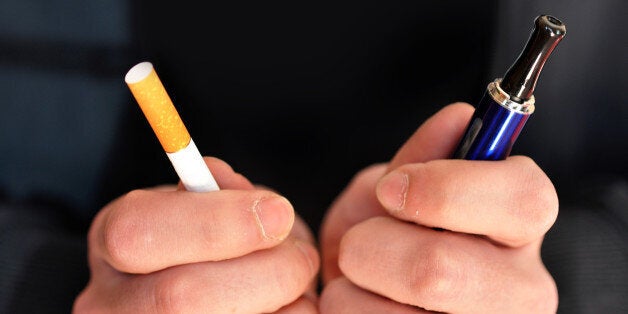
In 2015 Public Health England published a review stating that vaporizers were 95% less harmful than cigarettes. Afterwards NHS Smoke Free started to acknowledge their benefits as a viable quitting aid, yet reiterated that "the safety profile of e-cigarettes is still being established." Vaping is now universally lauded as the better option, but it would be foolish to assume that it is risk free... So I know what you're thinking. "Isn't switching from smoking to vaping just trading one bad habit for another?" You're absolutely right. However, transitioning to a vaporizer isn't the final step, it's merely a small portion of a long journey that could make the end goal more attainable.
When I made the conscious decision to give up smoking I had already moved on to vaping, not because I wanted to quit, but because is was popular among my social circle. Although cutting down smoking became a natural progression, it still took the best part of six months to completely wean off cigarettes. After deciding to quit I soon realized that there was a great deal to consider besides keeping a vaporizer handy and taking a drag when the urge kicked in; I needed to break the habits and associations around it.
If you're serious about quitting smoking through vaping, and don't want to fall into that difficult halfway territory where you start relying on a vaporizer yet don't call yourself a smoker, these tips -- based on my own personal experiences -- may help.
Inhale Like a Vaper
Cigarette smoking is completely different to vaping. While cigarette smokers take quick puffs, vapers tend to take long puffs. This is because all cigarettes -- regardless of brand -- are designed to provide a satisfying level of smoke with a single drag. Vaporizers, however, have hundreds of different configurations and a power button, allowing you to tailor the experience. It may feel a little strange at first; however, without a three inch stick telling you how much to inhale in one sitting, you'll probably find that one to three longer drags will be more than enough to subdue short-term cravings.
Stock Up in Advance
According to The Telegraph, the average vaping habit costs £30 per month, while pack-a-day cigarette smokers can easily spend up to £300 per month. Although it's much cheaper than smoking, expect to spend quite a bit of money to begin with. Get two batteries (so you don't slip up when your device is charging), four or five coils, and a decent supply of e-liquid. Vaporizers have a lifespan so having backup components will ensure you're covered when your device stops working properly. When selecting your flavour it would be wise to pick something that tastes like your chosen brand of cigarette. Don't bother experimenting too much in the early stages as it's better to keep everything familiar.
Identify Your Triggers
Try not to think of your journey as giving up smoking, but rather, breaking your smoking habits. Each time you control a trigger you're bringing yourself one step closer to cessation. Take baby steps and focus on the smaller goals. In fact, completely giving up smoking shouldn't be at the forefront of your mind at all in the early stages. For example, if lunch breaks are your trigger, avoid socialising in the smoking area for a while. When you feel ready, consciously place yourself in that difficult situation. When you've broken that trigger, focus on another trigger. And when you've broken all of your triggers -- or at least subdued them -- quitting won't seem like such a difficult task.
Don't Fear Failure!
This is probably the most important tip of all. When you make a conscious decision to give up smoking there are two ways to go about it: you can gradually reduce the amount of cigarettes you smoke or you can cut them out altogether. There is no right or wrong approach. The worst thing you can do is stop trying after a lapse. Don't look at it as a failure, but a learning experience. Identify the trigger the led to the lapse and make a conscious effort to avoid it in the future. If it happens again, it's no big deal, just rinse and repeat the process until you get it right.
Vaping has a major advantage over other methods of cessation as it's a direct replacement for cigarettes. However, when you've made the transition it's important to keep your eye on the long-term goal of giving up altogether. Gradually reduce the nicotine level in your e-liquid until you're down to zero. When you no longer feel the need for nicotine all you'll have to do is shake the habit itself, which will be much easier.
Vaporizing may be better for your health, but it's certainly not risk free. It doesn't matter if it takes days, weeks, months or even years to give up, as long as you move in the right direction. If you need a little boost for inspiration, check out this Smoking Timeline to monitor your progress and how it's positively affecting your health.
Good luck!